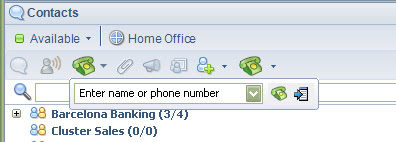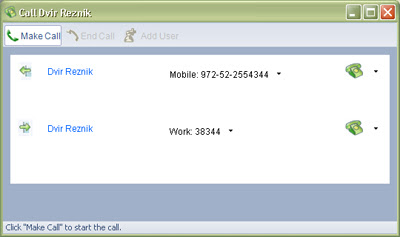 This past week at Brussels, Belgium gave me the opportunity to try out my latest Lotus Sametime 7.5.1 plugin – Dial Out. This plugin, part of IBM unified communication and collaboration solution gives the ability to dial out to any number, domestic or international. In the picture here you can see my top bar of Lotus Sametime Client. A quick overview of the different icons, from left to right: start a chat, start a voice chat (or video, if you have a camera), dial out (1st telephone icon), send a file, send an announcement to a group, share application or screen, add to buddy list, click to call (2nd telephone icon – will explain at the next paragraph). The dial out feature, which is connected to my Cisco VoIP extension at the office, enables me to dial out to any number and make a call with the other side, using my default speakers and mic. The person receiving the call sees my office extension on his caller id display. Pretty cool!
This past week at Brussels, Belgium gave me the opportunity to try out my latest Lotus Sametime 7.5.1 plugin – Dial Out. This plugin, part of IBM unified communication and collaboration solution gives the ability to dial out to any number, domestic or international. In the picture here you can see my top bar of Lotus Sametime Client. A quick overview of the different icons, from left to right: start a chat, start a voice chat (or video, if you have a camera), dial out (1st telephone icon), send a file, send an announcement to a group, share application or screen, add to buddy list, click to call (2nd telephone icon – will explain at the next paragraph). The dial out feature, which is connected to my Cisco VoIP extension at the office, enables me to dial out to any number and make a call with the other side, using my default speakers and mic. The person receiving the call sees my office extension on his caller id display. Pretty cool!
I made some calls during my stay at Brussels, and got excellent feedback from the other party. I did use the hotel’s Wi-Fi connection, which was relatively high band-width (although the hotel was fully booked), but still – it was an excellent way of staying in touch with co-workers, BPs and family, at a minimum cost. Much cheaper than using my mobile phone or any other service.
 Now a word (maybe a paragraph) about the other telephone icon – click-to-call.
Now a word (maybe a paragraph) about the other telephone icon – click-to-call.
The click-to-call is another plugin that simply connects 2 parties over regular phone lines, either mobile or land line. The method is similar to the ‘call-back’ option most carriers offer: you choose which number you want to dial, the system dials to you (lower rates for incoming call), then dials the other party – and connects you both. The picture should make it more clearer. If you have a low-band network connection, using click-to-call option is preferred.
Both features (Dial out and Click-to-call) are an excellent example of how you can integrate communication with collaboration, on a single platform. I (and others) have commented in the past about the benefits of Lotus Sametime, and its open platform that allows for various 3rd party extensions, and integrates seamlessly with leading telephony providers such as Cisco, Avaya, Siemens, Alcatel-Lucent, 3Com and Nortel.
Speaking of personal impressions of Lotus Sametime, I thought it would be relevant to mention some of our customer references. I choose these 2, as they reflect 2 very different companies, particularly highlighting the various applications of Lotus Sametime, and its high extendability.
The first is GE, one of the largest companies in the world, and one of the largest installation of
Lotus Sametime in the world (234,000 active users and 120,000 concurrent users).
Just some quotes from the case study [PDF, 140Kb]:
- People now communicate more frequently through Lotus Sametime than through e-mail. And when the network goes down, people don’t care about anything else. All they know is that Lotus Sametime is unavailable.
- This real-time communication facilitates faster decision-making and helps build relationships faster. When I look at my team, I see that it’s a way of making the whole team more productive.
The second case study is of Celina Insurance [PDF, 144Kb], a company with 175 employees, that actually uses Lotus Sametime to communicate with its independent insurance agents, via the company external portal. Using Lotus Sametime, the agents have direct and immediate access to Celina Insurance stuff, to get answers or address various issues. Again, some quotes:
- The agents appreciate that they can instantly connect with their Celina underwriter – or anyone else in the company – at the click of a button. We have even had a competitor call us to find out how we do that.
- As an alternative to drawn out e-mail chains and phone tag, it has proven to be a huge time saver, actually raising productivity while reducing phone calls (and associated costs) by 50 percent.
Here are the links to both case studies:
GE and Celina Insurance.


